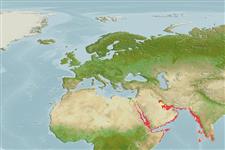Classification / Names
Common names from other countries
Main reference
Size / Weight / Age
Max length : 36.0 cm TL male/unsexed; (Ref. 11441); common length : 20.0 cm TL male/unsexed; (Ref. 5450)
Length at first maturity
Lm 19.8 range ? - ? cm
Environment
Marine; reef-associated; depth range 20 - 50 m (Ref. 28016)
Climate / Range
Tropical, preferred 27°C (Ref. 107945); 31°N - 5°N, 31°E - 82°E (Ref. 3810)
Distribution
Western Indian Ocean: Red Sea, Gulf of Aden, Gulf of Oman, Persian Gulf, Arabian Sea and Sri Lanka (Gulf of Mannar). This species has been misidentified as Scolopsides rupellii (=Scolopsis vosmeri) or as Scolopsis phaeops (= Scolopsis frenatus) by some authors.
Countries | FAO areas | Ecosystems | Occurrences | Introductions
Short description
Dorsal
spines
(total): 10;
Dorsal
soft rays
(total): 9;
Anal
spines: 3;
Anal
soft rays: 7. Head scales reaching forward to or just in front of level of anterior margin of eyes. Lower limb of preopercle scaly. Antrorse (forward-directed) suborbital spine absent. Pelvic fins long, reaching to level of anus. Axillary scale absent. Color: Upper body greenish-olive, whitish below. A narrow whitish stripe along base of dorsal fin. Another prominent black dark brown or black streak above lateral line beginning below about the third or fourth dorsal spine and ending on caudal peduncle. A bright blue stripe from eye to upper jaw and from posterior edge of the eye to base of pectoral fin, where it ends in a blue spot.
IUCN Red List Status (Ref. 115185)
Threat to humans
Harmless
Human uses
Fisheries: subsistence fisheries
More information
ReferencesAquacultureAquaculture profileStrainsGeneticsAllele frequenciesHeritabilityDiseasesProcessingMass conversion
Tools
Special reports
Download XML
Internet sources
Estimates of some properties based on models
Phylogenetic diversity index
PD50 = 0.5000 many relatives (e.g. carps) 0.5 - 2.0 few relatives (e.g. lungfishes)
Trophic Level
3.6 ±0.5 se; Based on size and trophs of closest relatives
Resilience
High, minimum population doubling time less than 15 months (Preliminary K or Fecundity.)
Vulnerability
Low vulnerability (18 of 100)
Price category
